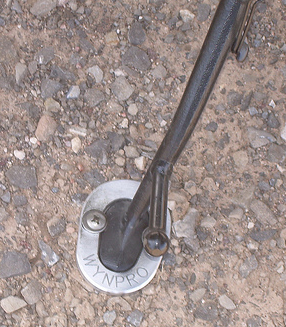bucky
Well-known member
I finally got tired of parking issues with my 3/4" kouba link lowered bike and worrying about the bike tipping over that I got out the MAPP gas torch, heated the sidestand and bent the sidestand so I get proper lean. By the way, easy to do. Takes maybe 10 minutes total. Now obviously the boot does not sit flat to the ground, but is about 3/8" off the ground on the high side.
Aside from the look with the stand down, the only worry I can see is that on very soft pavement or maybe gravel, the stand could more easily plow downward and the bike tip over. Now I normally carry a small 4" round piece of 1/8" aluminum to sit the sidestand on in those situations, but has anyone who has bent the sidestand down bent the end boot of the sidestand down so it sits flat? It does not look like it is possible, especially given the amount of bend needed to sit flat. Or a fabricated, wedge shaped boot to weld over the bottom of the original boot? Anyone make such a thing?
Any suggestions, especially from someone who has actually done this fix would be appreciated. Obviously I could cut the boot end off and have it re-welded to the proper angle, but that would be a permanent thing which I am trying to avoid. But maybe, who cares? Let the next owner worry about that if/when I sell.
Aside from the look with the stand down, the only worry I can see is that on very soft pavement or maybe gravel, the stand could more easily plow downward and the bike tip over. Now I normally carry a small 4" round piece of 1/8" aluminum to sit the sidestand on in those situations, but has anyone who has bent the sidestand down bent the end boot of the sidestand down so it sits flat? It does not look like it is possible, especially given the amount of bend needed to sit flat. Or a fabricated, wedge shaped boot to weld over the bottom of the original boot? Anyone make such a thing?
Any suggestions, especially from someone who has actually done this fix would be appreciated. Obviously I could cut the boot end off and have it re-welded to the proper angle, but that would be a permanent thing which I am trying to avoid. But maybe, who cares? Let the next owner worry about that if/when I sell.















